Summary: Equities fell to their August/September lows this past week and then reversed higher. A retest of the low would be normal, something to keep in mind in the event of an uncorrected rise from here. Any number of breadth and sentiment indicators strongly suggest that prices should rise further in the weeks ahead. The risk comes from oil prices, which remain too volatile to predict and which have been highly correlated to equities for several weeks.
After falling 3 weeks in a row, US indices closed higher. SPDR S&P 500 (N:SPY) and the Russell 2000 (RUT) gained 1.4% and the leader, the Nasdaq 100 (NDX), gained 3%.
Equities continue to follow oil, and oil closed the past week 5% higher. During the course of most days, the correlation between oil (United States Oil Fund (N:USO)) and SPY has been uncanny, with the two making daily highs and lows within minutes of each other. This relationship will eventually fade, but for now it remains the main story-line in the markets.

While the relationship is clear, oil is far more volatile. From December 29 (the recent high in equities and oil), the price of oil dropped 27% into Wednesday's close; SPX dropped 10%. Since Wednesday, oil gained 13%; SPX gained 3%.
Why are oil and equities tied together? It most likely has to do with perceptions that high yield defaults will soar, bankruptcies will rise and SPX earnings will drop; together this would seem to indicate that a recession is imminent. It's therefore important to recognize that contagion from energy remains minimal (post).
There is also a false perception that oil is crashing due to weak demand and that this is emblematic of a faltering global economy. This is incorrect; oil demand has recently surged to a new high (data from Yardeni).

The US economy continues to grow; In December, real retail sales reached a new high. It would have been even stronger if gas station sales hadn't dropped 15% yoy. The pattern before prior recessions has been for retail sales to at least stall, if not drop. This is clearly not the case at present (arrows).

If oil prices start to rise, will this hit corporate margins that have benefitted from cheap energy? Maybe, but history suggests that margins rise and fall with energy prices; meaning, overall margins (blue line) are best when energy companies are doing well and oil prices (red line) are rising.
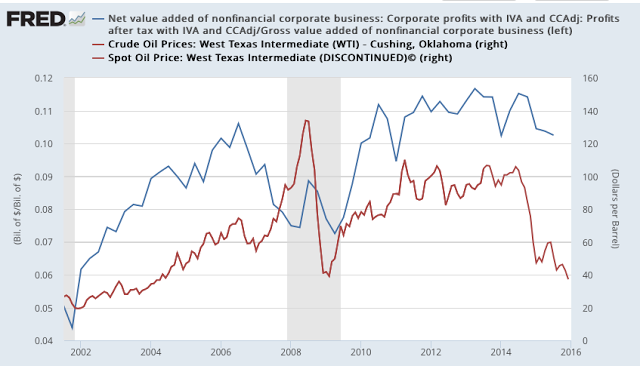

Have oil prices bottomed? Maybe, but prices hit a 13 year low just this past week so, despite the rebound, it is too early to say the bottom is in. We do know that the current fall is on par with prior significant drops in oil over the past 30 years. Those lows have corresponded mostly with positive returns in SPX going forward (lower panel). A low in oil would likely be a significant tailwind for equities.
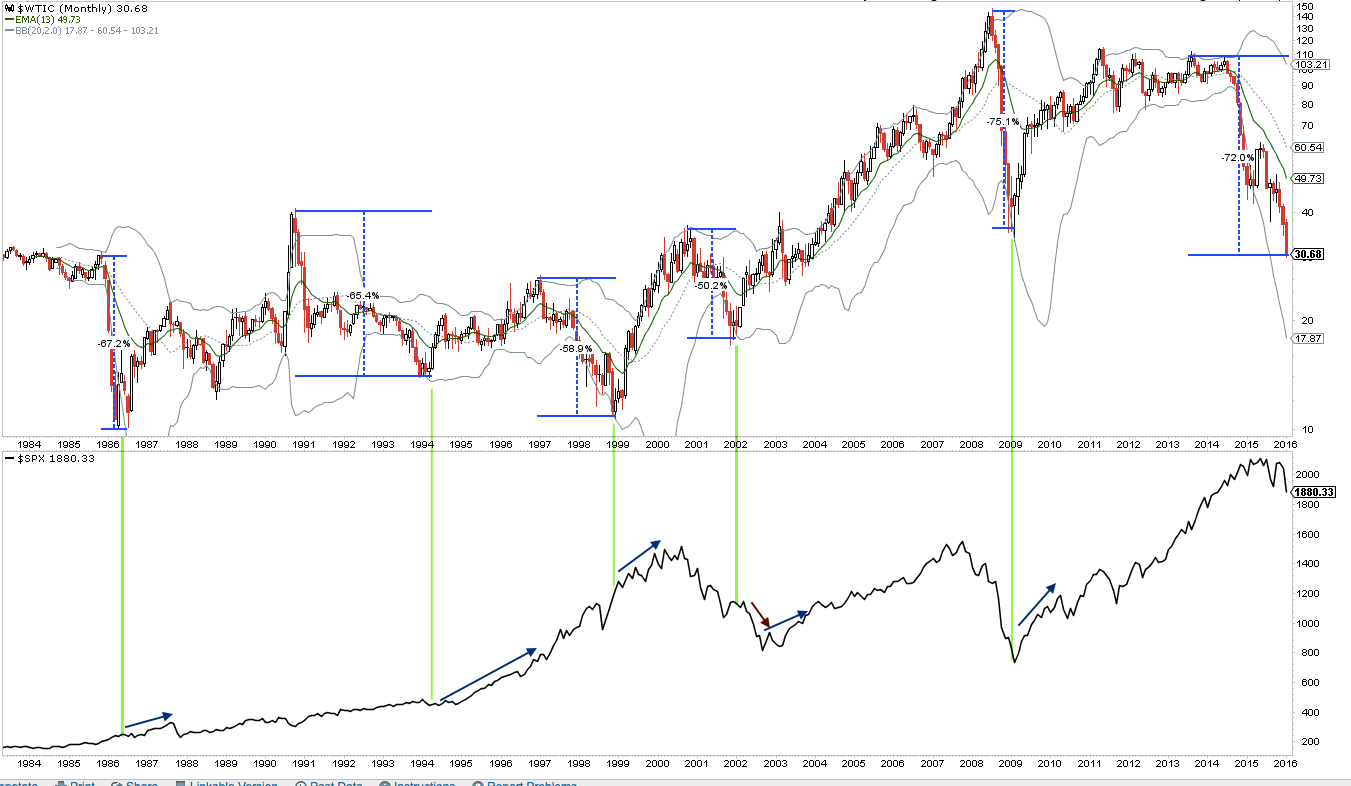
Importantly, further weakness in oil prices after this past week's bounce is the most obvious risk to equities. As we have said over the past two weeks, equities are "oversold" with respect to breadth and sentiment but these will mean little so long as oil is weak and the relationship to equities remains tight. That is still the case.
2016 is off to a bad start. SPX has already experienced a 9% drawdown. But this is not unusual. The average annual drawdown since 1980 has been 14%. It's been normal for drawdowns of the current magnitude to take place within the context of an uptrend. Even in the current bull market, drawdowns of 10% or more have taken place in most years: 2010, 2011, 2012 and 2015 (data from JPM).
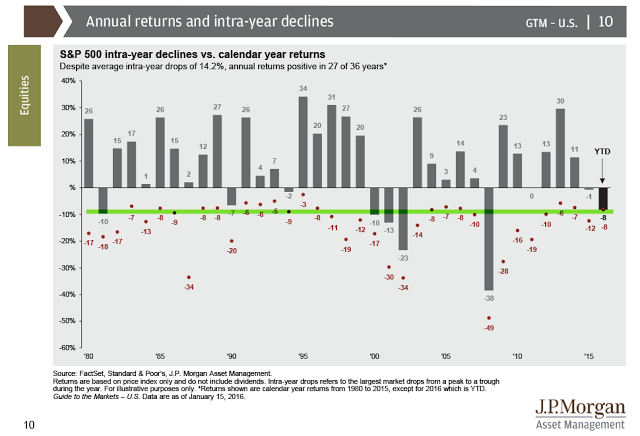
SPY and NDX both retested their August/September lows with a long pierce this past Wednesday. SPY rose 2.5% intraday from the low into the close. Sometimes triple bottoms don't hold, and sometimes they do. This past week's held.
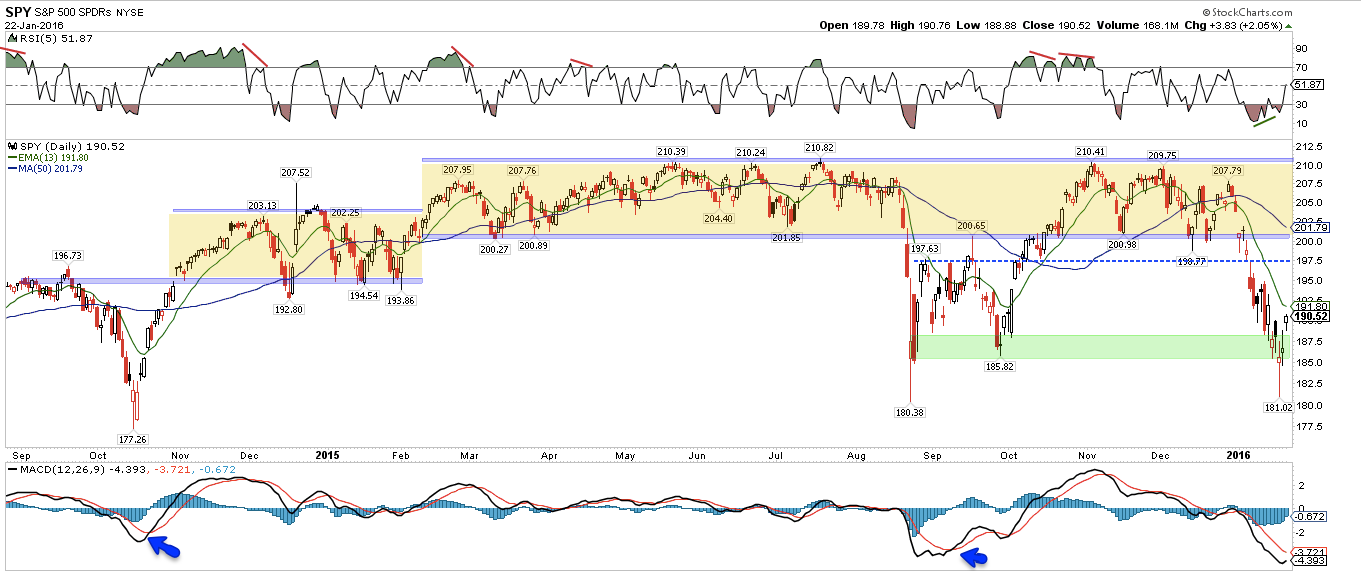
The more times that green area is tested, however, the more likely it is to fail. In the case of SPY, that would imply a fall to the October 2014 low near 178, a 6% drop from Friday's close.
Support at this past week's low is much stronger for NDX. This wasn't just the August/September 2015 support area but also the prior highs from late 2014 and the prior lows from early 2015 (left side of the chart). That's a meaty area of support that would probably withstand another retest in the weeks ahead.

The reversal last Wednesday and follow-through on Thursday and Friday put in what appear to be stairs that now lead higher. Ideally, the next low will be above 188 (bottom of step) and the next high will reach 193-195 (top of the next step).

(In the chart above, note that there's also a possible inverted head and shoulders pattern that targets the 198-199 area. The head is highlighted in green).
Using Fibonacci ratios, targets for a retrace of the recent fall are 193 (38%), 196 (50%) and 199 (68%). These levels correspond to gains from here of 1%, 3% and 4.5%, respectively. If SPY repeats the pattern from August, it will rise to $200, which was an important area of support during most of 2015 (yellow shaded section two charts earlier). That would equate to an 8% gain from Wednesday's close. Is this a reasonable target? Yes.
Over the past 8 weeks, $46.5b has flowed out of equity mutual funds and ETFs. In the last 13 years, the only comparable periods were early 2008 and mid-2011. The 2011 low marked the start of a new bull leg. Even in 2008, SPY rose 8% over the next several weeks before faltering. Another 8% from Wednesday's close targets 200 on SPY (data from Lipper and Sentimentrader).
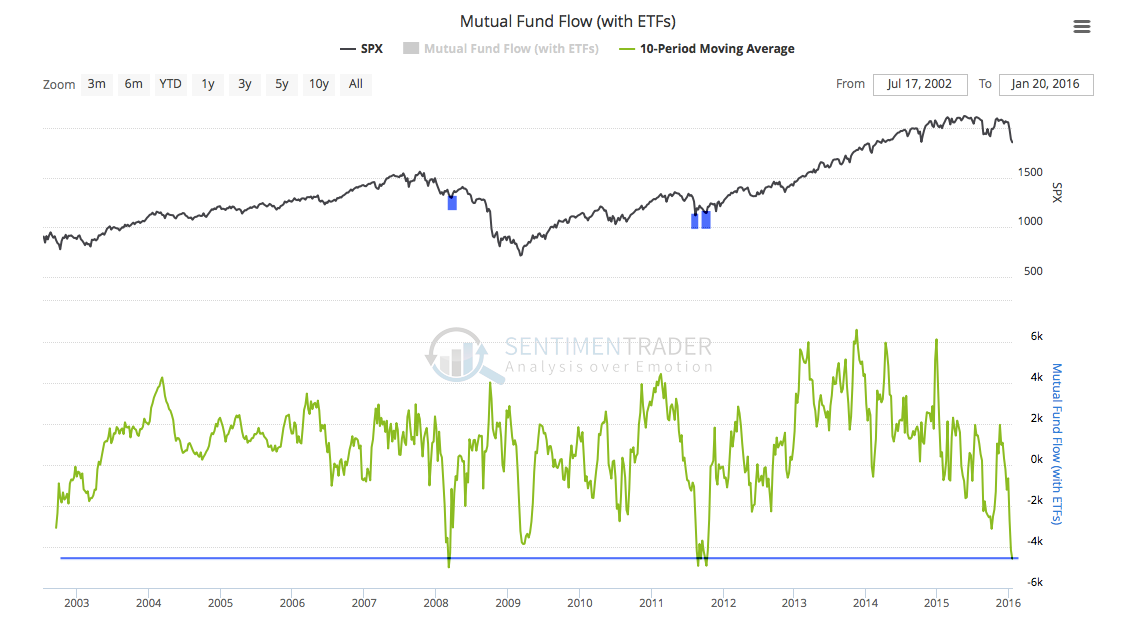
The sell-off has rattled investors. Fund managers surveyed by BAML now have the third largest allocation to cash since 2009. Global allocations to equities dropped in half in the past month. Since 2009, equity allocations have only been lower in mid-2010, mid-2011, mid-2012 and mid-2015; All of these periods were notable lows for equity prices during this bull market. Allocations to US equities remain near an 8-year low. These factors are normally very bullish for equities. A new post on this, here.
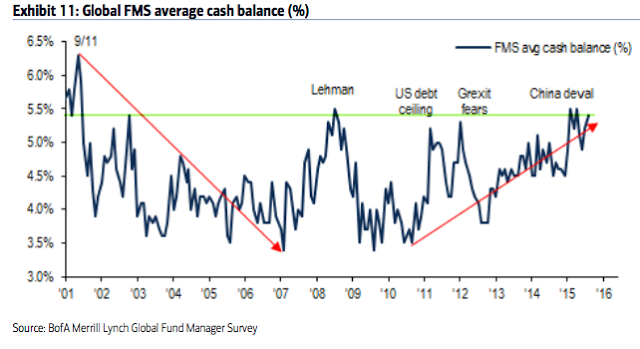
Similarly, breadth is washed out to a degree that most often leads to higher equity prices. One example is the number of new lows, which reached 40% of all issues on the NYSE this past week. In 14 of the 15 prior situations like this since 1970, SPX has traded higher over the next 1-2 months and also over the next one year (data from Dana Lyons).

Will the recent low be retested? Most often (but not always) large falls retest their lows, even if the "retest" is a "higher low". The chart below looks at 2 week falls in SPX of greater than 5%; a high proportion retested their low (closing basis), although the lag could be weeks apart.

The data in the chart above is from the 1990s. The next chart looks at the past 6 years; falls of 10% are circled. In each case, the low was retested. Note: the blue line is the equity exposure of active investors polled by NAAIM; You can see that current sentiment is consistent with prior lows after similar drops in SPX (green line; data from NAAIM).
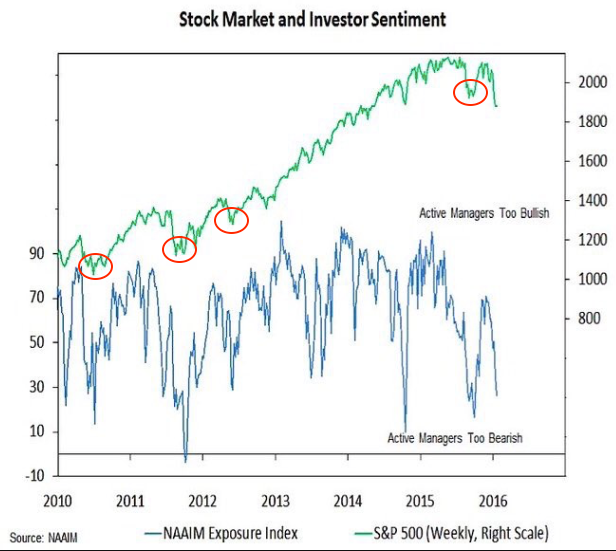
In summary, equities fell to their August/September lows this past week and then reversed higher. A retest of the low would be normal, something to keep in mind in the event of an uncorrected rise from here. Any number of breadth and sentiment indicators strongly suggest that prices should rise further in the weeks ahead. The risk comes from oil prices, which remain too volatile to predict and which have been highly correlated to equities for several weeks.
The upcoming week could be strongly affected by news. It is the biggest week of the 4Q 2015 earnings season, with Apple (O:AAPL) reporting on Tuesday. The FOMC meets and releases a statement on Wednesday. Durable goods and GDP/ECI are on Thursday and Friday, respectively.
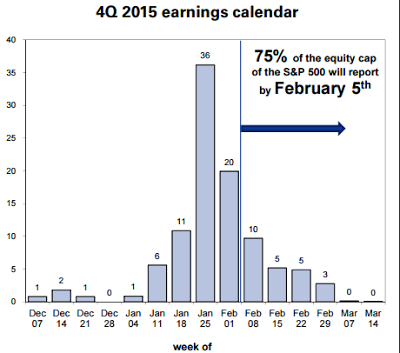
Companies can engage in buybacks after reports are issued, meaning that significant corporate buying may resume after this week and next.
Further reading: Bear markets rarely take place outside of an economic recession. In the post-World War II era, only two bear markets have occurred outside a recession. A new post on this is here.
